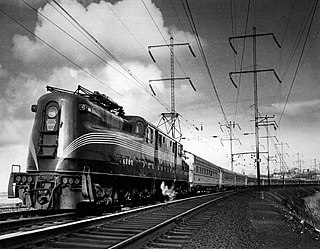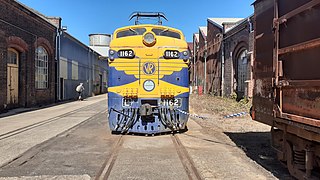
A switcher locomotive, shunter locomotive, or shifter locomotive is a locomotive used for maneuvering railway vehicles over short distances. Switchers do not usually move trains over long distances. Instead, they typically assemble trains in order for another locomotive to take over. Switchers often operate in a railyard or make short transfer runs. They may serve as the primary motive power on short branch lines or switching and terminal railroads.

The EMD AEM-7 is a twin-cab four-axle 7,000 hp (5.2 MW) B-B electric locomotive built by Electro-Motive Division (EMD) and ASEA between 1978 and 1988. The locomotive is a derivative of the Swedish SJ Rc4 designed for passenger service in the United States. The primary customer was Amtrak, which bought 54 for use on the Northeast Corridor and Keystone Corridor. Two commuter operators, MARC and SEPTA, also purchased locomotives, for a total of 65.

An electric locomotive is a locomotive powered by electricity from overhead lines, a third rail or on-board energy storage such as a battery or a supercapacitor. Locomotives with on-board fuelled prime movers, such as diesel engines or gas turbines, are classed as diesel–electric or gas turbine–electric and not as electric locomotives, because the electric generator/motor combination serves only as a power transmission system.

The Pennsylvania Railroad GG1 is a class of streamlined electric locomotives built for the Pennsylvania Railroad (PRR), in the northeastern United States. The class was known for its striking art deco shell, its ability to pull trains at up to 100 mph, and its long operating career of almost 50 years.

The Little Joe is a type of railroad electric locomotive built by General Electric. The locomotives had twelve axles, eight of them powered, in a 2-D+D-2 arrangement. They were originally intended to be exported to the Soviet Union and designed to operate on Soviet Railways (SZhD) 3,300-volt DC overhead line system. They were never exported to the Soviet Union due to rising political tensions. Only 20 were built, with 15 sold to domestic operators and five exported to Brazil.

An electro-diesel locomotive is a type of locomotive that can be powered either from an electricity supply or by using the onboard diesel engine. For the most part, these locomotives are built to serve regional, niche markets with a very specific purpose.

Crocodile electric locomotives are so called because they have long "noses" at each end, reminiscent of the snout of a crocodile. These contain the motors and drive axles, and are connected by an articulated center section. The center section usually contains the crew compartments, pantographs and transformer.
The Pennsylvania Railroad's class P5 comprised 92 mixed-traffic electric locomotives constructed 1931–1935 by the PRR, Westinghouse and General Electric. Although the original intention was that they work mainly passenger trains, the success of the GG1 locomotives meant that the P5 class were mostly used on freight. A single survivor, prototype #4700, is at the National Museum of Transportation in St Louis, Missouri.
Railroad electrification in the United States began at the turn of the 20th century and comprised many different systems in many different geographical areas, few of which were connected. Despite this situation, these systems shared a small number of common reasons for electrification.

The NER Class ES1 was a class of two steeplecab electric locomotives commissioned by the North Eastern Railway in 1902.

The GE E60 is a family of six-axle 6,000 hp (4.5 MW) C-C electric locomotives made by GE Transportation Systems (GE) between 1972 and 1983. The E60s were produced in several variants for both freight and passenger use in the United States and Mexico. GE designed the locomotive for use on the Black Mesa and Lake Powell Railroad (BM&LP), a dedicated coal-hauling route in Arizona, which began operation in 1973. That same year GE adapted the design for high-speed passenger service on Amtrak's Northeast Corridor. The largest customer was Ferrocarriles Nacionales de México (NdeM), the state-owned railroad in Mexico, which bought 39 for a new electrification project in the early 1980s.

The Victorian Railways L class was a class of electric locomotives built by English Electric and operated by the Victorian Railways and later V/Line from 1953 until 1987 primarily on the Gippsland line. They were the only class of main line electric locomotive operated in Victoria.

The Victorian Railways E class was a class of electric locomotive that ran on the Victorian Railways (VR) from 1923 until 1984. Introduced shortly after the electrification of the suburban rail system in Melbourne, Australia, and based on the same electrical and traction equipment as Melbourne's early suburban electric multiple unit fleet, they provided power for suburban goods services and shunting for six decades.

The South African Railways Class 7E is an electric locomotive. South African Railways placed 100 Class 7E electric locomotives with a Co-Co wheel arrangement in service in 1978/79. They were the first 25 kV AC locomotives to enter service in South Africa.

The South African Railways Class 11E of 1985 is an electric locomotive.

The GE U26C diesel locomotive model was introduced by GE Transportation Systems in 1971. All examples of this model are six axle units, and have the wheel arrangement C-C or Co'Co'.

The SNCF BB 1280 class were a class of 600 V DC 4 axle Bo′Bo′ electric locomotives, formerly Compagnie du chemin de fer de Paris à Orléans machines, initially built for an underground section of line connecting the Gare d'Austerlitz to the Quai d'Orsay in inner Paris. The locomotives were converted for 1500 V DC use in the 1930s, and renumbered PO E.281 to E.293. They were absorbed by the SNCF, and operated as shunters until the late 1960s.

Baldwin, the locomotive manufacturer, and Westinghouse, the promoter of AC electrification, joined forces in 1895 to develop AC railway electrification. Soon after the turn of the century, they marketed a single-phase high-voltage system to railroads. From 1904 to 1905 they supplied locomotives carrying a joint builder's plate to a number of American railroads, particularly for the New Haven line from New York to New Haven, and other New Haven lines. Westinghouse would produce the motors, controls, and other electrical gear, while Baldwin would produce the running gear, frame, body, and perform final assembly.

The BB 13000 class were electric locomotives operated by SNCF in France. They were one of four classes, together with the BB 12000, CC 14000 and CC 14100 classes, that formed an experimental group for studying the practicality of the new French 25 kV 50 Hz AC electrification.

The Great Northern Z-1 was a class of ten electric locomotives built for the Great Northern Railway They were used to work the route through the second Cascade Tunnel. They were built between 1926–1928 by Baldwin Locomotive Works, with Westinghouse electrics, and stayed in service until dieselisation in 1956. Each was of 1,830 horsepower (1,360 kW) with a 1-D-1 wheel arrangement, although they were always used in coupled pairs.


























